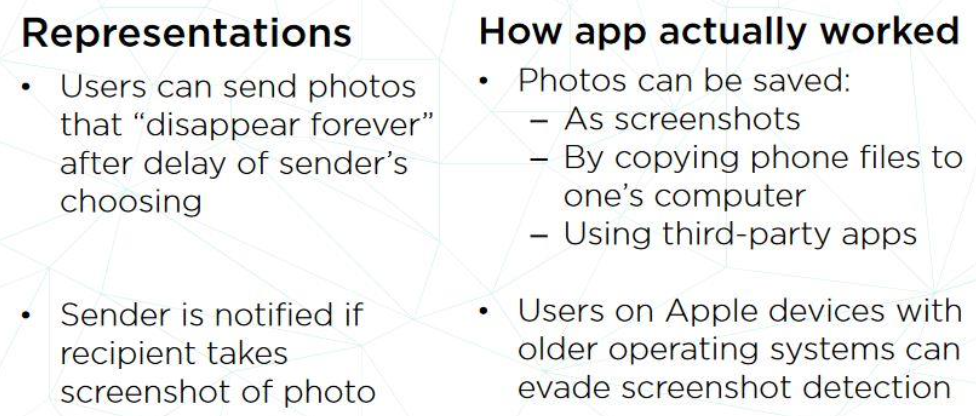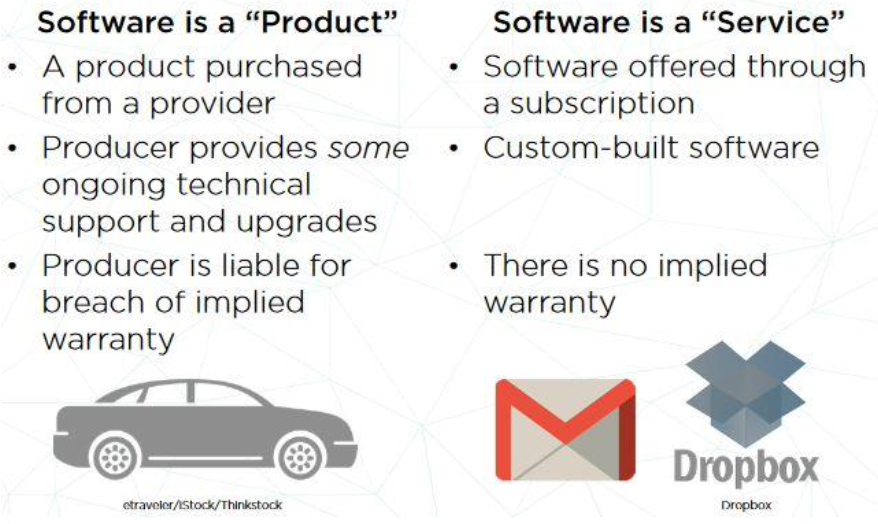Software Product Liability
Let’s start with tort law, which deals with compensating injured parties for damages by a noncriminal act (called a tortious wrong).
In the case of product liability, a tortious wrong can simply be the existence of a defect that causes major damage. Fortunately, this type of tortious claim does not occur often in software liability lawsuits. As we saw in the unit on perfect software, it is impossible to achieve error-free software. Therefore, punishing developers for simply having errors in their software would place an unreasonable burden on them.
More often, the tortious wrong has to do with some breach of duty by the software producer, such as:
- Breach of duty to use reasonable care in the development of the product
- Breach of duty to warn the user of known material defects or of special operating instructions
- Breach of duty to accurately represent the product to consumers
Let’s consider each of these cases.
Negligence
Negligence is a breach of duty to exercise a reasonable degree of care in the development or delivery of a product or services.
When it comes to developing software, producers have a duty to take reasonable steps to ensure product quality and safety.
It includes:
- Testing a program properly
- Fixing significant bugs
- Warning users of limitations of the program
- Providing adequate instruction on how to use the program
- Providing adequate security against unauthorized uses of the software
Negligence is a finding of fault where the producer receives blame for:
- A design error that ought to have been avoided, or
- A manufacturing error that ought to have been detected and corrected, or
- A failure to warn users of a known or foreseeable danger.
A producer can also be liable for negligence by business partners or by the suppliers of component parts! In other words, a producer might be found negligent even when they perform no tortious wrong themselves, but because they chose the wrong partners.
Misrepresentation
Another type of tortious wrong is to misrepresent the capabilities of a software product, either in oral or written claims about the product. Courts will often grant some leeway to small exaggerations made in advertising. However, if a user suffers damages because they reasonably relied on inaccurate/misleading claims about the software - claims that the producer knew or ought to have known were untrue - then the producer is liable.
Misrepresentation
Making untrue, inaccurate or misleading claims about a software product.
Example: Snapchat claiming that photos and videos set would “disappear forever”
 The US Federal Trade Commission filed a complaint that listed multiple counts in which Snapchat’s marketing and practices constituted deceptive acts or practice in violation of a Federal Trade Commission Act. The company agreed to a settlement in May 2014.
The US Federal Trade Commission filed a complaint that listed multiple counts in which Snapchat’s marketing and practices constituted deceptive acts or practice in violation of a Federal Trade Commission Act. The company agreed to a settlement in May 2014.
Breach of Warranty
Contract law can also come into play in cases of software liability because the sale of a software product is effectively a contract between the seller and the buyer. That contract may include certain stated or implied conditions, or warranties, that require upholding by the parties.
For example: the creation of an express warranty occurs when the seller of a product makes explicit promises to the buyer about the functionality or quality of the software. The promises might be made:
- in a written guarantee or warranty
- through oral discussions with the buyer
- through and advertisement or marketing brochure
- through demonstration of the product.
If the product does not live up to the seller’s promises, there is a breach of warranty, and the seller is liable for any losses caused by the breach.
Express Warranty
Explicit assurances provided by the seller that the product is of a specified quality.
Implied Warranty
Implicit assurances imposed by law that the product is of “Merchant Quality”.
Liability Law In Quebec
Liability law in Quebec is different.
For example, in Quebec, a breach of warranty can be grounds for cancelling a contract or sale.
As another example, there is no distinction in the types of damages available for award in a tortious liability lawsuit versus a contractual liability lawsuit.
In general, liability laws are different in different countries. If you are a software producer, the commercial and product liability laws in each country where you sell your products are binding.
Liability Law in the United States
Each individual states have their own sets of commercial laws. However, most of the 50 states have a commercial laws based on Uniform Commercial Code (also called the UCC).
The UCC is very similar to the Canadian common laws - including the idea that all products come with an implied warranty of mechantability.
However, the UCC applies only to the sale of goods and not to the sale of services. Therefore, only if software is deemed a good in the United States does the UCC apply.
A fundamental difference between the laws in the two countries is that the product liability law in the United States includes strict liability - a manufacturer can be held liable for a defect in a product without being found negligent.
Strict liability
A software producer being liable for software errors (such as incorrect computations or data losses) that cause the user to suffer a major loss.
Product Liability Applied To Software
Not clear when a piece of software is a product or a service, or both and the product liability law depends on that since they are treated differently.
Software is often considered a good or a product purchased from a provider. These days, the relationship between the software producer and the buyer rarely ends at the point of sale. The software producer may provide free-of-charge technical support and upgrades (at least for a certain period), up until the next major release of the software.
However, this ongoing relationship between manufacturer and consumer exists for other types of products (like automobiles) and thus does not preclude viewing software as a good (Exactly in the case of Blackberry QNX).
In contrast, if the software is provided through a subscription or runs on a remote computer (like Gmail or Dropbox), then it looks much more like a service being provided rather than a product. Further, if the software is custom-built as a deliverable of a consulting contract, then it is most likely to be considered a service provided by the consultant.

Minimizing Liabilities
How software producers can protect themselves against excessive liabilities?
How can we eliminate all errors and errors that remain in the product pose a liability risk.
To mitigate these risks, software producers often take legal measures to reduce, shift, or share their risk of liabilities - typically by asserting warranty and liability disclaimers in contracts and licence agreements.
Think back to the End-User License Agreements. They are agreements that users click on Accept or I agree button blindly before accessing a new piece of software. Those agreements often include clauses that limit user’s ability to seek compensation in the event that a software error causes major losses or damage. Warranty